Abstract
In German, complement clauses embedded by the wh-word wie (‘how’) have two different readings. The first is a manner reading expressing a manner or method of doing something. The second is called eventive in this paper because it expresses an event in progress instead of a manner. Ruling out ambiguity of wie, the question arises of why a manner word is used to express an event in progress. The basic semantic hypothesis in this paper is that wie expresses similarity (as it does in, e.g., similes). The paper starts from the observation that in the manner reading wie has a base position next to the verb and is a modifier of the event type whereas in the eventive reading it is base-generated above VP and thus adds information about the event token. The analysis includes two components: First, manners are considered as sets of similar events (instead of primitive objects), and methods, in particular, are considered as sets of similar sequences of subevents. Secondly, events in progress are seen as initial sequences in sets of similar natural continuations. From this point of view, an event in progress is like a method comprising sequences of subevents that share the same initial part. This analysis provides a semantic interpretation explaining why the wh-word wie expresses both the regular manner reading and the eventive reading depending on whether it modifies the event type or the event token.
Similar content being viewed by others
Avoid common mistakes on your manuscript.
1 Introduction
German wie (‘how’) is, first of all, a question word asking for a manner or method. It occurs in many syntactic environments, most prominently in questions, as in (1). In this paper, we focus on clausal complements introduced by wie, which give rise to two types of readings. First, there is a manner reading, as shown in (2). This reading allows for clarification questions with wie to be answered by the manner (pure manner or method) in which the event was performed (answer 1, answer 2). Secondly, there is a reading which is not a manner reading but instead close to bare infinitives and that-clauses, and is preferably translated into English by progressives, see (3).Footnote 1 This reading does not allow for wie clarification questions, but only for questions addressing the reason or way the event came about. We name it the eventive reading of wie-complements.
-
(1)

-
(2)
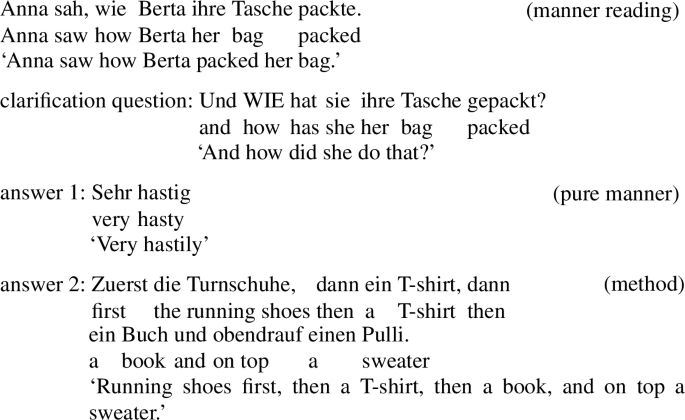
-
(3)

The semantics of wie-complements is puzzling for a number of reasons. First, there is the question of how the eventive reading comes about. Restrictions on the embedding verbs make it obvious that eventive wie-complements denote neither questions nor propositions, since embedding under fragen and wissen (‘ask’, ‘know’) is blocked (see example (16) below). In the rare literature on eventive wie-complements it is agreed that they induce a process-perspective such that the event is presented as a scene or situation or process. This observation is confirmed by the fact that nominal labels for eventive wie complements are nouns like Vorgang, Szene or Begebenheit (‘process’, ‘scene’, ‘event’) (see example (6d) below). We will therefore assume that eventive wie-complements denote events in progress.
Manner wie-complements denote, first, questions or propositions. This is obvious when they are embedded under matrix verbs like fragen and wissen (‘ask’, ‘know’). When embedded under perception verbs or report verbs like sehen and erzählen (‘see’, ‘report’), manner wie-complements have to be analyzed as free relative clauses denoting DPs of type manner. Both variants require, however, a manner interpretation of the wh-word wie, and even though the semantics of questions and free relative clauses is in general well understood, there is no agreement about the denotation of manner questions and manner free relatives—are manners properties of events or should they be treated as primitive ontological entities? Thus a semantic analysis has to address the issue of what the nature of manner is, in addition to (or even before) addressing the interpretation of wie-complements.
The third and most puzzling issue is the word wie itself. There are a number of languages featuring a non-manner interpretation of manner wh-words, and it would clearly not be adequate to assume that there are two homonymous manner words in language after language. Focusing on German wie, an analysis is required explaining why wie is used to introduce events in progress in addition to manners of events. So from the perspective of German (as well as Russian and Polish, for example) the question arises: Why should a manner word be used to indicate an event in progress?
The analysis presented in this paper includes four building blocks. The first consists in assuming two different syntactic base positions of wie. We follow, on the one hand, Frey (2003) in assuming a verb-adjacent base position of manner adverbs in German and, on the other hand, Legate’s (2010) proposal of an in situ base position of English how in non-manner clauses. Manner wie is base-generated within the VP while eventive wie is base-generated in the left periphery of the clause. This entails that manner wie is a modifier of an event type while eventive wie is a modifier of an event token. This difference is at the core of the semantic analysis.
The second building block is provided by the similarity interpretation of wie. This interpretation has been suggested for equative comparison constructions (Anna tanzte wie Berta. ‘Anna danced like Berta did’) where wie is said to express a similarity relation between events. The notion of similarity is implemented in multi-dimensional attribute spaces (Umbach and Gust 2014).
The third building block is about the semantics of manner wie-complements. We propose to consider manners—pure manners as well as methods—as similarity classes of events of a given event type (for details see Sect. 5.1). Methods, in particular, are understood as similarity classes of sequences of subevents. When occurring as free relative clauses (embedded under, e.g., sehen ‘see’), manner wie-complements denote manner similarity classes (instead of primitive manner objects), and when occurring as interrogative clauses (embedded under, e.g., fragen ‘ask’) they denote propositions asserting that an event is in a particular manner similarity class.
The fourth building block is the semantic interpretation of eventive wie-complements. We start from the observation that eventive wie-complements express events in progress and, furthermore, from the idea that an event in progress is given by an initial sequence of subevents plus possible continuations of the proper type. We make use of the analysis of methods as similarity classes of sequences of subevents and provide a similarity-based characterization of events in progress which is close in spirit to Landman (1992) and Bonomi (1997). Bringing these two views together, eventive wie-complements are analyzed as methods, i.e. similarity classes of sequences of subevents, such that they share a given initial sequence (a stage in Landman’s terms).
According to this analysis, the core difference between the manner and the eventive reading is the attachment point of the wh-word wie. In the case of the manner reading it is attached to the event type given by the verb, and it generates classes of similar events of this type; in the case of the eventive reading it is attached to the event token made available by higher functional projections, and it generates classes of similar natural continuations of this token.
In Sect. 2, the data will be discussed. Section 3 presents the (rare) literature on German wie-complements and Legate’s (2010) article on English how clauses. From there on, our paper is organized along the building blocks listed above: Sect. 4 presents the syntactic analysis. Section 5 presents the semantic analysis starting with a brief overview of the similarity framework, proceeding with the semantics of manner wie-complements and ending with the semantics of eventive wie-complements.
Although non-manner uses of manner wh-words are found in a number of languages including Russian, Polish, French, Greek and Hebrew, and also in English, this paper focuses exclusively on German, since there seems to be considerable variation between languages. While in Russian and Polish non-manner uses of manner wh-words match semantically with the findings for German, English non-manner uses of how clearly differ in meaning. Cross-linguistic comparison requires substantial additional research, which has to be left for future work.
2 The data
When considering a sentence hosting a wie-complement in isolation, the reading of the complement may not be obvious. In (1), for example, the difference between the manner reading and the eventive reading is manifest only when taking the different clarification questions into account. In this section, a number of characteristics will be reviewed that help distinguish the two readings—accenting, continuations, nominal labels, adverb position and coordination. Furthermore, we will consider the matrix verbs licensing the respective readings. We will see at the end of this section that the difference between the manner reading and the eventive reading is subtle and sometimes even negligible.
In the rest of the paper manner readings and eventive readings of wie-complements will be distinguished by subscripts (\(\mathit{wie}_{\mathrm{M}}\) / \(\mathit{wie}_{\mathrm{E}}\)), which should not be misunderstood to mean that the word wie itself is ambiguous. As for terminology, we will use the term manner in a broad sense covering pure manner, see (4a), instrument, see (4b), and method given either as a single more concrete event, as in (4c), or as a sequence of subevents, as in (4d). We will focus on the latter.
-
(4)

Consider the manner wie-complement in (5). Accent on the wh-word is licit although not obligatory, cf. (5a). The sentence is naturally continued by specifying a manner or method, cf. (5b, c). Nominal paraphrases make use of the nouns Art or Weise (‘manner’, ‘way’), cf. (5d).
-
(5)
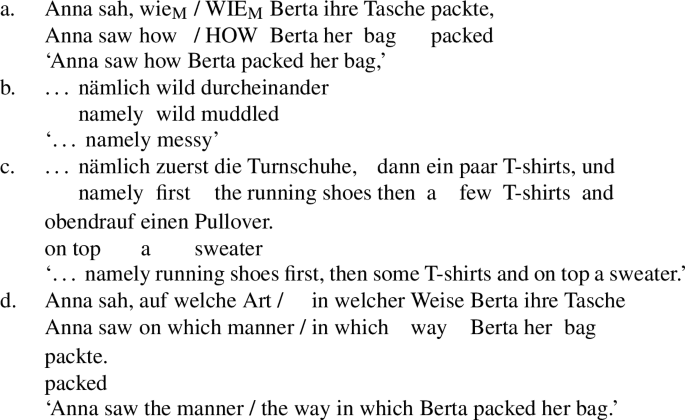
Eventive readings, in contrast, do not license accenting of the wh-word, (6a). Subsequent sentences preferably add another event, (6b), while namely-specifications are blocked, (6c). Labels in paraphrases are nominals like Szene, Situation, Vorgang and Begebenheit (‘scene’, ‘situation’, ‘process’, ‘event’), confirming the intuition that eventive wie-complements emphasize a process perspective, see (6d).
-
(6)
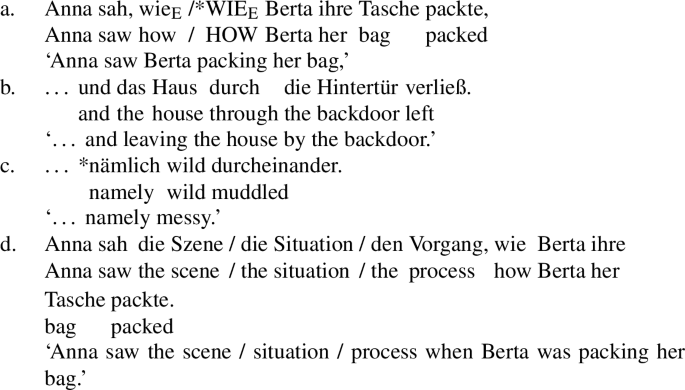
If wie is combined with a gradable adverb, it functions as a degree modifier and the adverb is fronted together with the wh-word. Degree readings of wie-complements allow accenting of the wh-word and subsequent degree specifications, see (7), as well as paraphrases making use of degree nominals like Geschwindigkeit ‘speed’, (8). In other respects they pattern with manner readings, which is why they will not be considered separately.
-
(7)

-
(8)

Even though degree readings will not be in focus in this paper, we will make use of the syntactic behavior of gradable adverbs as an additional feature distinguishing manner readings from eventive readings: If a gradable adverb in a wie-complement stays in situ, as in (9), the eventive reading is the only option, which is evidenced by the fact that accenting and namely continuations specifying manners are hardly acceptable, see (10). Gradable adverbs thus provide a fairly reliable test for disambiguation: If a gradable adverb can be inserted next to the verb, the reading is most likely eventive.Footnote 2 But if a gradable adverb is fronted together with the wh-word, the wie-complement has a degree reading, which we subsume under the notion of manner reading. We will come back to this issue in the syntactic analysis in Sect. 4.
-
(9)

-
(10)

Another test distinguishing manner readings and eventive readings is based on coordination (this test is due to Zimmermann 1991). A manner wie-complement can be conjoined with a wh-interrogative of any type, see (11). Note that licensing of the adverb sorgfältig ‘carefully’ subsequent to the wh-word indicates the manner reading of the first conjunct. In contrast, an eventive wie-complement can only be conjoined with other eventive ones, as in (12a). Coordination with a manner wie complement or another wh-interrogative appears much less coherent, see (12b).
-
(11)

-
(12)
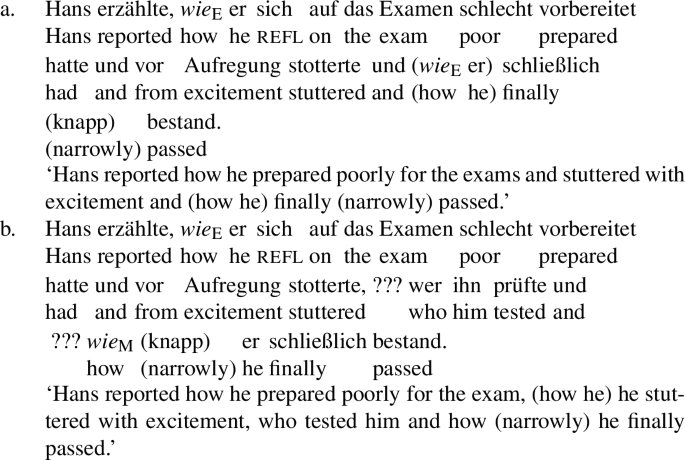
There are two types of complement clauses that are close in meaning but not equivalent to eventive readings of wie-complements, namely dass ‘that’ complements and bare infinitives, (13b,c). Eventive wie-complements differ from dass-complements, first, in entailing direct perception when embedded under perception verbs. While in (13b) indirect evidence would be sufficient—Anna may, e.g., see clothing scattered across the room—(13a) entails that Anna actually saw Berta. Direct perception has first been discussed by Barwise (1989), who showed that in the case of bare infinitives embedded under perception verbs indirect evidence would not suffice.
Another feature relevant in perception is epistemic neutrality: does the agent know what she is seeing? Bare infinitives are epistemically neutral, since (13c) will be true even if Anna does not realize that Berta is packing her bag. In contrast, neither eventive wie-complements nor dass-complements are epistemically neutral, (13a) and (b) entail that Anna recognizes Berta’s activity as packing a bag (see Barwise 1989 and Sect. 3).
-
(13)
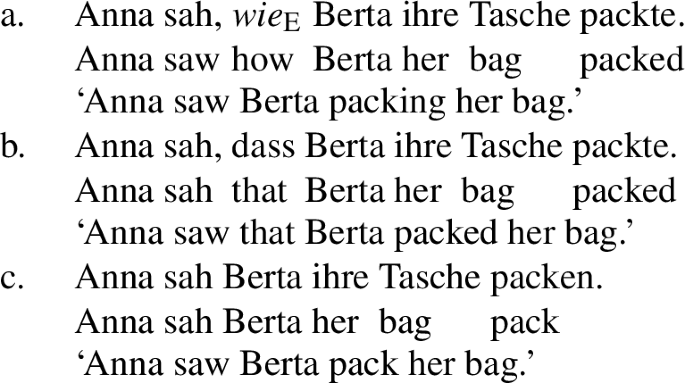
The most important feature in the context of our paper, however, is the observation that eventive wie-complements, in contrast to dass-complements and bare infinitives, emphasize the process-like nature of the described event and present it as ‘ongoing.’ This will be the starting point of the semantic analysis of eventive wie-complements in Sect. 5.3.
From the point of view of the matrix clause, wie-complements—manner as well as eventive ones—are verbal arguments which are required by the subcategorization frame of the matrix verb, see (14a,b). They must not be confused with temporal wie-clauses, as in (14c), where the required argument is given by the nominal and the wie clause functions as an adjunct (analogous to the temporal als-clauses in 14d).
-
(14)
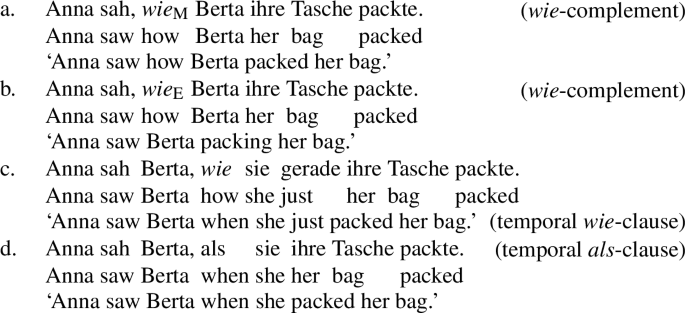
Matrix verbs embedding manner readings of wie-complements include, on the one hand, interrogative and factive verbs and, on the other hand, perception verbs, cognitive verbs and report verbs, (15a,b). Verbs generally blocking wh-interrogatives, like glauben, behaupten (‘believe’, ‘assert’) also block manner readings of wie-complements, (15c). Manner wie-complements embedded under interrogative and factive verbs are commonly analyzed as interrogative clauses denoting questions. When embedded under perception verbs, cognitive verbs and report verbs they are analyzed as free relative clauses, i.e. DPs denoting manners (see Sect. 5.2).
-
(15)
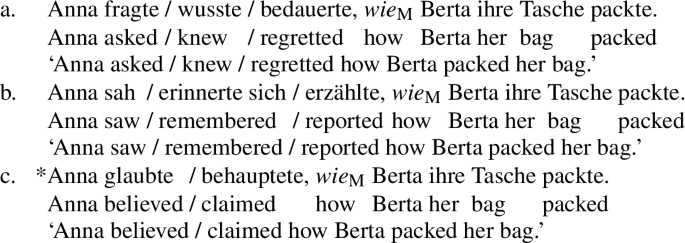
Matrix verbs embedding eventive wie-complements include perception verbs, cognitive verbs and report verbs, cf. (16a). Eventive complements are blocked under interrogative and factive verbs (and also under believe type verbs), cf. (16b,c) (note that the wie-complements in (16) are clearly eventive due to adding a gradable adverb in front of the verb).
-
(16)
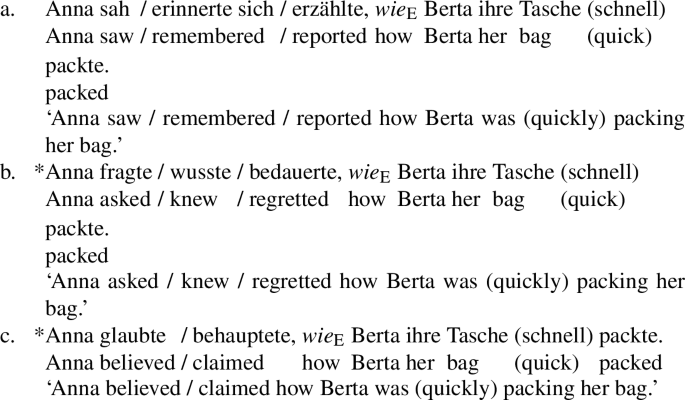
In (17) verbs are listed which have been attested to embed eventive wie-complements in a corpus study (Mieskes et al. 2007), thereby disproving the widely held claim in the literature that eventive wie-complements are restricted to perception verbs (see Sect. 3).
-
(17)
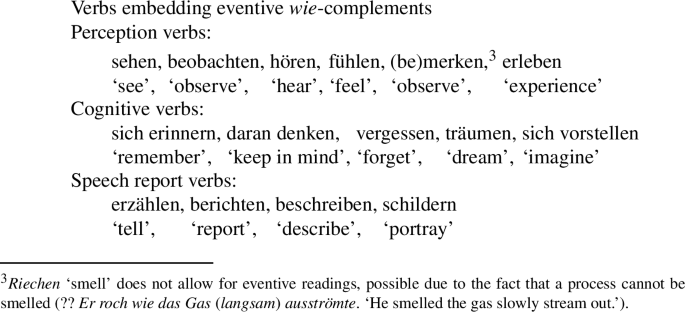
So we can conclude that the set of verbs embedding eventive wie-complements is a subset of the verbs embedding manner complements, excluding interrogative and factive verbs.Footnote 3 However, it is not always straightforward to decide for an individual example what the intended reading is, since the difference in meaning is sometimes subtle. In (18), naturally occurring examples are shown which favor an eventive reading (though a manner reading cannot be ruled out with certainty).Footnote 4
-
(18)
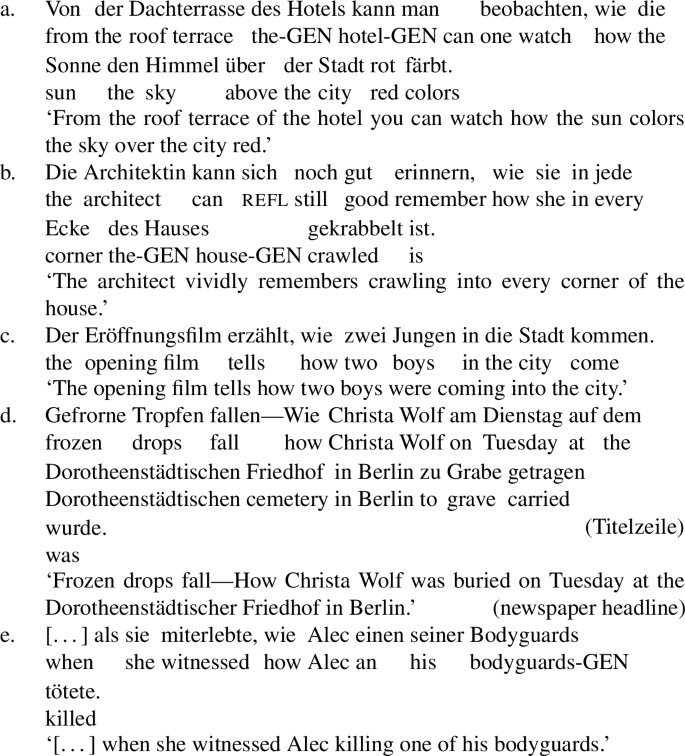
In the example in (18a) the eventive reading is preferred since the manner is already given (den Himmel rot färben ‘color the sky red’). It may be objected that rot in rot färben is not a manner but instead a result and there might still be different ways of doing that, but this interpretation would be quite unlikely. Similarly, in (18b) a manner reading is implausible because the verb already specifies a particular manner of movement (crawling). Again, there might be different ways of crawling and thus a manner reading cannot be excluded with certainty. In the example in (18c) the prominent reading is an eventive one since a film, first of all, reports an event. But in reporting an event, it has to present a sequence of subevents and this sequence may already be considered as a manner (or method) of performing the event. Example (18d) is a newspaper headline, without a matrix clause. The prominent reading is the eventive one even though headlines do not in general block manner readings.Footnote 5 As in the case of the film, as soon as an event is reported by way of a sequence of subevents, the difference between the two readings gets blurred.
Example (18e) is deliberately presented without context and, as such, is ambiguous between a manner and an eventive reading of the wie-complement. Disambiguation is possible with the help of a gradable adverb, say grausam (‘cruelly’). If the adverb is in its base position, the reading is presumably eventive. But if it is fronted together with the wh-word, it yields a degree reading, (which we subsume under the notion of manner), see (19a,b).Footnote 6
-
(19)

Applying the coordination test demonstrated in (12) is evidence again for the ambiguity of (18e). Without further context the wie-complement can be conjoined with other wh-clauses, yielding a manner reading, as in (20a), and it can be conjoined with other eventive readings yielding an eventive reading, as in (20b).
-
(20)
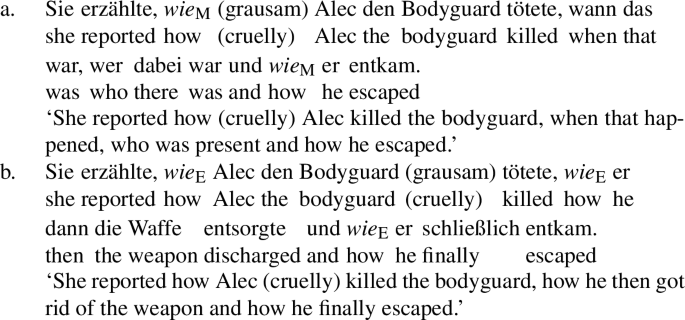
Summing up the data, the contrast between manner and eventive wie-complements is perfectly clear when embedded under interrogative and factive verbs because these verbs block the eventive reading. In the case of perception verbs, cognitive verbs and report verbs the difference is subtle. One may enforce an eventive reading with the help of an adverb in the preverbal position. On the other hand, one may enforce a manner reading by accenting the wh-word or by conjunction with different wh-clauses. But without auxiliary measures the difference stays blurry and frequently even appears irrelevant. This is something to be reflected in the semantic analysis.
3 The literature
The literature on German eventive wie-complements is rare. The Duden grammar (2006) as well as the comprehensive IDS grammar (Zifonun et al. 1997) mention them only in passing, claiming that their occurrence is limited to perception verbs in the matrix clause and that they stress the process-like character of the event. Similarly, Bayer (1986) acknowledges that wie-complements may have a non-manner interpretation, though he excludes this interpretation from his analysis.
There are three articles directly dealing with eventive wie-complements, namely Clement (1971), Vater (1975), and Falkenberg (1989). All of them assume that eventive wie-complements occur only under perception verbs, and they unanimously agree that eventive wie-complements, in contrast to dass ‘that’ complements, emphasize the process of the described event and block stative verbs. Falkenberg in fact argues that eventive wie-complements behave semantically like English progressives (which will be the starting point of the semantic analysis in Sect. 5.3).
Talking about perception verbs, there is first of all Barwise (1989) on Scenes and other Situations. However, contrary to what Clement, Vater and Falkenberg claim, the occurrence of eventive wie-complements is not limited to perception reports. The criteria employed by Barwise—direct perception, epistemic vs. non-epistemic seeing and veridicality—are important in distinguishing bare infinitives as well as wie-complements from that-clauses but they are no help in distinguishing manner from eventive wie-complements.
In the context of German subordinated wie-clauses the article by Zimmermann (1991) should be mentioned. Zimmermann’s paper is the only one showing that eventive wie—she calls it subordinating conjunction wie—not only occurs with perception verbs but also with report verbs. She considers eventive wie and manner wie as different words since the latter has the status of a syntactic phrase whereas the former is—in her analysis—a mere conjunction. Semantically, she argues that eventive wie differs from dass (‘that’) in expressing that the event in question is a process and is equipped with an additional covert property: “dass charakterisiert den bezeichneten Sachverhalt nüchtern als existierend, wie tut die Anspielung auf Eigenschaften des betreffenden Vorgangs hinzu.” (‘dass soberly characterizes the stated facts as existing, wie adds the allusion to particular properties of the process’). Our analysis in Sect. 5.3 will confirm Zimmermann’s view and explain the nature of the covert property.
While rejecting a connection between manner and eventive wie, Zimmermann nonetheless suggests a connection between eventive wie and the temporal conjunction wie which expresses simultaneity between the events in the matrix and the subordinated clause, see (21b). In her analysis there is a linguistically covert event which is subject to the covert property mentioned above running in parallel to the complement clause event. Her analysis captures the connection between eventive wie and temporal wie in a way that can straightforwardly be implemented in a modern aspectual semantics framework (e.g., Demirdache and Uribe-Etxebarria 2004), which has to be left for future work though.
-
(21)
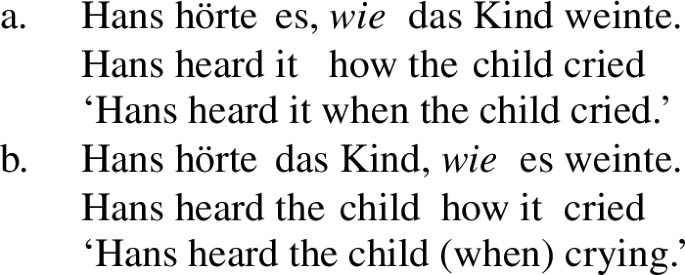
Broadening the perspective beyond German, there is first of all Legate’s (2010) paper on English how showing that in colloquial English how complement clauses may have a non-manner interpretation, as in (22).
-
(22)

According to Huddleston and Pullum (2002), non-manner how-complements are equivalent to that-complements, and how in these contexts has to be reanalyzed as a declarative subordinator. Nevertheless they have to concede that non-manner how complements cannot, e.g., occur under believe (Huddleston and Pullum 2002:954). Legate thus argues that non-manner how-clauses differ syntactically from that-clauses in behaving like DPs instead of CPs and are thus free relative clauses instead of interrogatives. But since in contrast to regular free relatives there is no evidence for movement, how must be base-generated in its surface position. This is accounted for in the syntactic structure in Fig. 1 (= 27 in Legate 2010) where how is in the specifier of CP position without being moved from a position lower in the clause.
(27 in Legate 2010).
Legate’s proposal is discussed in detail in Nye’s dissertation in (2013). Nye agrees with Legate that non-manner how is base-generated above TP, but argues that it occupies the head rather than the specifier position and that a non-manner how complement has clausal instead of nominal status. We will not go into details here since syntax is not in focus in this paper.
More importantly, Nye adds a wide range of examples to those presented by Legate, all in all leading to the conclusion that English non-manner how complements differ substantially from German eventive wie-complements. First, they appear informal in register, whereas German eventive wie-complements are unmarked with respect to register. Secondly, they allow for a number of embedding matrix verbs the German equivalents of which cannot embed eventive wie-complements, e.g., promise, forgive, find out. The English examples are evidence that non-manner how-clauses license negation and stative content, as in (22) above (which can by no means be translated into German by using a wie-complement), and that unlike German eventive wie, English non-manner how does not induce a process perspective (actually, none of Legate’s examples is a progressive).Footnote 7 Finally, following Legate, English non-manner how-clauses can be paraphrased by the way that, which would be impossible in German and even in English is surprising for a non-manner meaning (Fig. 1).
Recently, Liefke (to appear) presented an account solving the discrepancy between German and English by postulating two types of English non-manner how clauses (in addition to regular manner clauses). One of them has an eventive interpretation (as suggested in this paper for German) and occurs preferably embedded under verbs of perception. The other one has a factive interpretation, as in (22) above, and occurs under factive and presuppositional verbs (see Kastner 2015), preferably verbs of cognition and speech report. Semantically, eventive how is analyzed in parallel to manner how while factive how is analyzed in parallel to (factive) that.
Liefke’s analysis focusses on English how clauses that are non-manner and at the same time not eventive (like (22) above), and provides a number of interesting entailment data. It is unclear, however, how the difference between eventive how and manner how is accounted for. Furthermore, by postulating two different types of non-manner how the connection between eventive how and factive how remains unexplained.
One of the basic premises in the present paper is that the word wie is the same in manner as well as eventive wie-complements. There is a broad range of languages which exhibit non-manner interpretations of manner words. Legate mentions French, Greek and Hebrew. Other languages would be Spanish, Italian, Norwegian, Dutch, Russian, Polish, Serbian, Bulgarian, and Basque (see Jędrzejowski and Umbach in preparation). This is strong evidence against the idea of random homonymy—why should there be two (or more) homonymous manner words in language after language? But then there is the question of why a manner word is used to indicate a non-manner interpretation, which is the starting point of the analysis in our paper. We will adopt Legate’s syntactic proposal and focus on semantics. It is important to keep in mind though that the semantic analysis in this paper is aimed at German.
4 The syntactic analysis: Two base positions of wie
The analysis of wie-complements requires, just like that of complements in general, consideration of internal aspects as well as restrictions imposed by the matrix verb. Taking the internal perspective, the primary issue is the base position of the wh-word, which will be argued to be different for manner and eventive readings of wie-complements. From the external perspective, the difference between interrogative complements and free relative clauses must be accounted for.
Recall that we use the term manner in a broad sense covering pure manner, instrument and method.Footnote 8Pure manner is typically given by adverbs, instrument is typically given by prepositional phrases and method is typically given by indem (‘by’) clauses (Behrens and Fabricius-Hansen 2002), see (23a-d). It is important to note that a method may consist of a single more concrete instance of the verbal predicate, but it may also include a sequence of subevents, as in (c) and (d). All of these manner variants can be asked for by wie and may thus be targeted by manner wie complements.
-
(23)
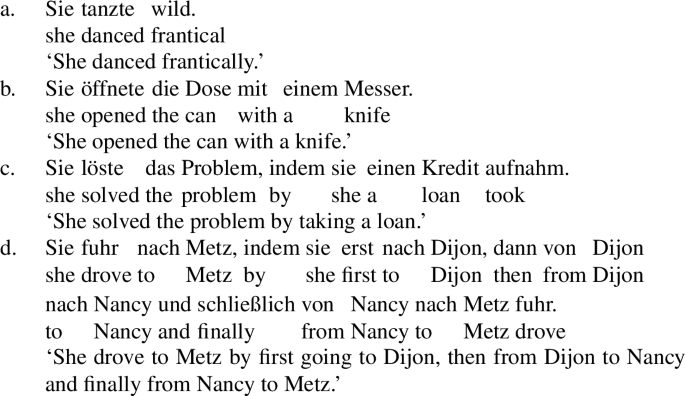
We follow the standard account of adverbial modifiers in German (Frey 2003; Maienborn 2003; Schäfer 2013) in assuming that the base position of manner modifiers is adjacent to the verb, which is evidenced by clarification questions, see (24). Since wie is a wh-word, it is moved to the front of the clause or, in terms of syntactic structure, to the specifier of CP.
-
(24)
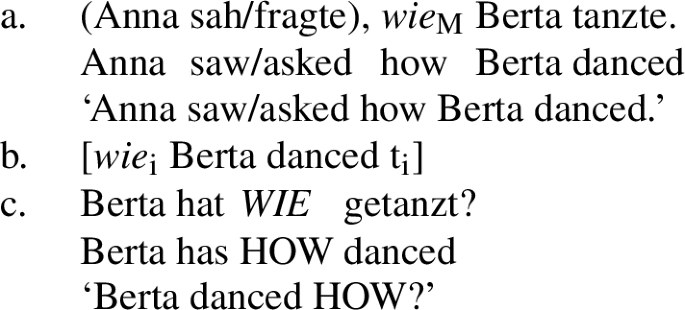
If wie is combined with a gradable adverb, it acts as a degree modifier and the adverb is fronted together with the wh-word. We follow Schäfer (2013) in assuming that, e.g., the degree phrase wie schnell in (25a) has been moved from the original verb adjacent manner position. This entails that in (25a) the manner position is occupied, even though by a trace. Therefore, if a gradable adjective overtly occurs in the manner base position, as in (25b), the fronted wh-word cannot result from movement out of the manner base position. For this reason, the wie-complement in (25b) does not have a manner reading: If the manner position is overtly occupied, wie cannot normally represent manner—wie-complements with a gradable adjective adjacent to the verb are most likely eventive.Footnote 9 Thus adding gradable adverbs provides a fairly reliable way to decide between the two readings.
-
(25)

Sæbø (2016) considers English how questions distinguishing between manner (in our terms: pure manner) and method, and refers to the observation by Jaworski (2009) that how questions can be interpreted in different ways. Answering the question in (26) by (a) indicates a manner interpretation while (b) and (c) indicate a method and instrument respectively.
-
(26)

Sæbø argues that manners are adjuncts providing restrictions of verbal predicates while methods are arguments of abstract verbal predicates implementing the action. He postulates that there are two types of verbal predicates, abstract ones equipped with an argument slot for a method, and concrete ones without such a slot. This account makes strong predictions—abstract predicates should always occur with a method specification, and by-gerunds combine only with abstract predicates—and it has to resort to coercion when by-gerunds are chained. In view of these problems we will adhere to the mundane idea that manners, including methods, are adjuncts.Footnote 10
From the perspective of the matrix clause, the primary issue is the type of the embedded clause—are wie-complements interrogatives or free relative clauses? As shown in Sect. 2, wie-complements may be embedded by verbs like fragen and wissen (‘ask’, ‘know’) which gives them the status of interrogative clauses, see (27a). Interrogative wie-complements can only have manner readings: (27b) is hardly acceptable, because the gradable adverb in the manner base position blocks a manner interpretation (compare (10) in Sect. 2). When embedded under perception verbs, cognitive verbs and report verbs, we consider wie-complements as free relative clauses (e.g., Caponigro 2004; Hinterwimmer 2013), that is, they have the status of DPs. Free relative wie-complements may then have either a manner or an eventive reading, (27c).
-
(27)
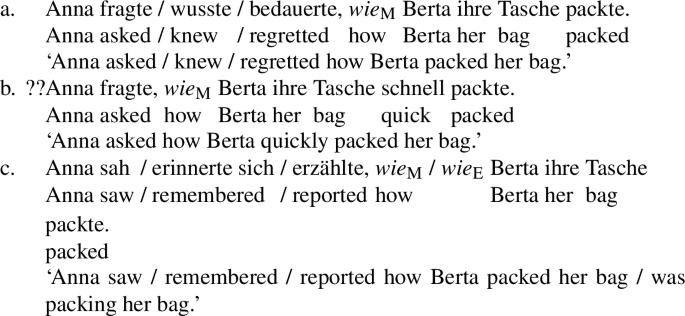
We thus follow Legate (2010) in assuming that eventive wie-complements are free relative clauses and denote DPs. Nye (2013), in contrast, argues for a clausal status presenting contexts which appear to be restricted to clausal complements. We won’t go into the English data here, it suffices to see that none of the embedding verbs of eventive wie-complements exclusively selects for clauses.
The other syntactic issue with eventive wie-complements is the position of the wh-word. Since it does not function as a manner modifier of the verb, it cannot be base-generated in the manner position adjacent to the verb. We follow Legate again in assuming that wie in eventive readings is base-generated in its surface position, i.e. in the left periphery. Legate suggests that English non-manner how is generated as a specifier of CP, that is, in the same position that manner how occupies after movement. The other option would be the head of CP position where complementizers are located. Nye presents tests that speak, in her opinion, for non-manner how to be in the head position. That would, however, require reanalysis of the wh-word as a complementizer.
The syntactic difference between manner and eventive wie-complements—the wh-word being based generated in a verb-adjacent position as opposed to being base-generated as a specifier of CP—will in fact be the pivotal point to explain the semantic difference between manner and eventive wie-complements: In a verb-adjacent position the manner modifier combines with the event type, whereas in the specifier of CP position the modifier—whatever it is called—combines with the token event. Modifying an event type amounts to run-of-the-mill intersective modification. Modifying an event token is like non-restrictive modification of DPs, just adding a property to a particular entity.
Summing up, we will assume the syntactic structures shown (greatly simplified) below. The one in (28) is that of interrogative (manner) wie-complements. (29) and (30) represent free relative clauses. The manner free relative and the eventive one are nearly identical: In both structures wie is in the specifier of CP position. The only difference is that, in the manner structure, there is a trace of wie in the manner base position next to the verb. This difference will be the starting point for the semantic analysis in the next section.
-
(28)

-
(29)

-
(30)

5 The semantic analysis: Similarity of events and of stages
The semantic analysis of wie complements—manner as well as eventive—is based on the idea that the wh-word wie denotes similarity, as it does in, e.g., equative constructions. Manners in general are understood as similarity classes of events.Footnote 11 Eventive wie is analyzed as a special case, namely as indicating methods, i.e. classes of similar sequences of subevents, which share a given initial sequence, or stage in terms of Landman (1992).
In Sect. 5.1 we will briefly introduce the similarity framework our analysis is based on. Technical details will be reduced to a minimum. Then, in 5.2 a semantic analysis of manner wie-complements will be proposed that makes use of manners considered as similarity classes instead of primitive entities. Section 5.3 is about the semantics of eventive wie-complements. The core point is the idea of capturing their process-like nature by interpreting them as an initial sequence in a method similarity class.
5.1 The similarity framework
In Umbach and Gust (2014) and Gust and Umbach (to appear), a generalized account of German equatives is proposed including scalar as well as non-scalar occurrences, see (31). This approach is based on the idea that equatives express similarity, which is implemented as indistinguishability with respect to a given set of dimensions, and similarity is the contribution of the standard marker wie. Thus the standard marker wie is not semantically empty (as assumed in standard degree semantics), but instead denotes a similarity relation: In (31a), Anna’s height is said to be similar to Berta’s height; in (31b) Anna’s speed at running is similar to Berta’s speed; in (31c) Anna’s table is similar to Berta’s table; finally in (31d) Anna’s way of dancing is similar to Berta’s way of dancing.
-
(31)
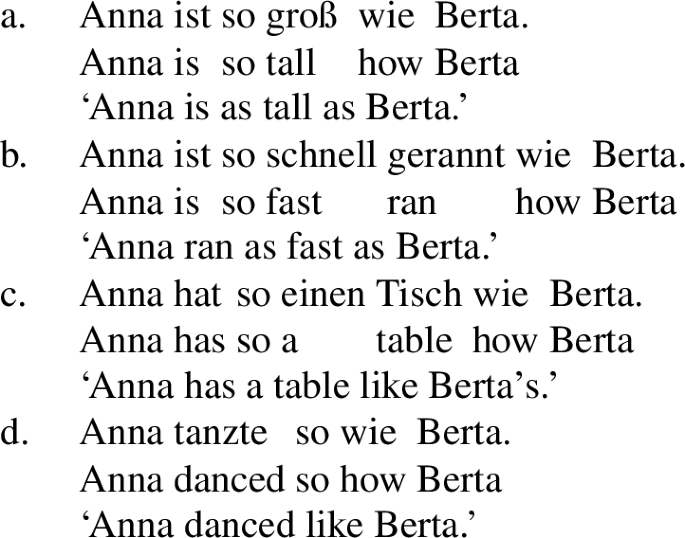
We will assume that the wh-word in wie-complements has the same meaning as the standard marker wie in equatives, viz. similarity. It has to be kept in mind, however, that similarity in our framework is implemented as indistinguishability with respect to a given set of features and should not be confused with the meaning of the English word similar (for differences see Umbach and Gust 2021).
The similarity analysis of equatives is close to the kind analysis suggested in Anderson and Morzycki (2015) since in the nominal and verbal case (though not in the adjectival case) similarity classes created by wie correspond to ad-hoc formed kinds. This is evidenced by experimental findings showing that features of comparison are restricted to “in virtue of” properties (Greenberg 2003) which are commonly considered as essential in kind formation (see König and Umbach 2018; Umbach and Stolterfoht in preparation). In the verbal case, these features correspond to what is called “event-internal modifiers” of manner verbs in Schäfer (2013).
The basic idea of the similarity analysis of equatives is such that the wh-word wie heading the standard clause is interpreted as a 3-place similarity relation, SIM(x, y, ℱ). Variables x and y represent items to be compared (individuals or events) and ℱ is a contextual parameter called representation including, among other things, the relevant dimensions of comparison.
Consider the verbal equative in (31d): In the similarity analysis the wie clause expressing the standard is interpreted as a free relative clause, i.e. a DP denoting a set of events similar to Berta’s dancing with respect to particular features of comparison, see (32a,b). It will be argued in the next section that manner wie-complements have exactly the same interpretation—[Anna sah / Anna tanzte so] wie Berta tanzte—they are DPs denoting sets of events similar to Berta’s dancing, see (32b).Footnote 12
-
(32)

It would, of course, be unsatisfactory if similarity would just be a primitive predicate. Therefore, similarity is spelt out with the help of three components which are combined in a representation ℱ. The basic idea of our framework is to have a referential semantics where predicates talk about entities in the world, and a representational layer where classifiers talk about auxiliary items like degrees, numbers, symbols etc., and vectors thereof. Entities of the world are related to auxiliary items by processes of measurement or feature extraction.
The framework includes three components. First, there are multi-dimensional attribute spaces defined by 1 − n dimensions of arbitrary scale types (metric, ordinal or nominal)—note that scales in degree semantics can be seen as 1-dimensional spaces with a metric scale level. Secondly, there are generalized measure functions mapping individuals and events to points in attribute spaces; they can be seen as generalized versions of adjectival measure functions (cf. Kennedy 1999): While adjectival measure functions map individuals to degrees on a single ratio type dimension, generalized measure functions map individuals to vectors with multiple dimensions of arbitrary scale types (including ordinal and nominal scales). Thirdly, there are classifiers, which are defined as predicates over points in attribute spaces; they determine granularity by providing a “grid” such that points within a cell cannot be distinguished.
Similarity of individuals or events is defined by indistinguishability with respect to a representation ℱ such that two individuals or events are similar if and only if the points they are mapped to are indistinguishable.
Let us take the verb dance as an example. We focus on tango and assume, for the sake of the example, that relevant dimensions of comparison are level, style, figures, decoration (with scale types ordinal, nominal, ordinal, metric). Then a dancing event is “measured” by the function in (33), that is, level, style, figures, and the number of decorations are taken into account. Now suppose that Berta’s dancing is high level Milongero style, and includes Ochos and Ganchos and five decorations. So it is mapped to <high level, Milongero, {Ochos, Ganchos}, 5>. Suppose, moreover, that there is a classifier—let us call it stylish*—conflating advanced and high level and disregarding the difference between Ochos and Ganchos while requiring the number of decorations to be more than three. A classifier to this end would be the one in (34). Accordingly, the class of dancing events similar to Berta’s dancing—dancing like Berta does—includes all events mapped to points within the range of stylish*.
-
(33)

-
(34)

Similarity classes of events represent manners. In the example above Berta’s manner of dancing would be described as “high level Milongero style including Ochos and Ganchos and five decorations” which is pure manner. Manner in the sense of instrument refers to an instrument dimension (for example, {hammer, knife, poison, gun} in the case of killing). Manners in the sense of methods (which is what we are interested in in this paper) specify sequences of subevents of performing an event of a certain type. Sequences of subevents are represented by strings and are implemented as values of a dimension sequence (for a string-based view of events see Fernando 2015). We define:
-
(i)
A method measure function \(\mu _{\mathit{seq}} : E \rightarrow S\) takes events to strings of names of basic events.
-
(ii)
Strings are partially ordered by a relation initial-part-of such that for strings α and β, α≤init β iff length(α) ≤ length(β) and \(\alpha _{\mathrm{i}} = \beta _{\mathrm{i}}\) for index i from 1 to length(α).
-
(iii)
The initial-part-of relation on strings in attribute spaces is reflected by an initial-sequence-of relation on events: e ≼ f iff μseq(e) ≤init μseq(f).Footnote 13 (Initial sequences correspond to stages in Landman 1992.)
Let us consider bag-packing events. Suppose that there is a generalized measure function μbag-pack mapping bag-packing events to an attribute space with dimensions sequence, diligence and others. Values of the sequence dimension are strings (see (i) above), values of the diligence dimension range from 1 to 5; other dimensions will be ignored for the sake of exposition, see (35a).
Whether two events count as similar is—as in the case of Tango dancing—a matter of classifiers. In (35b) a classifier small-bag* is shown that does not distinguish between 3 and 4 pairs of socks, or between a sweater and a down jacket, and diligence is just above minimum. Suppose that there are two events e1 and e2 mapped by μbag-pack to vectors as shown in (36a) and (b). According to the small-bag* classifier, the events e1 and e2 cannot be distinguished and thus count as similar.
-
(35)
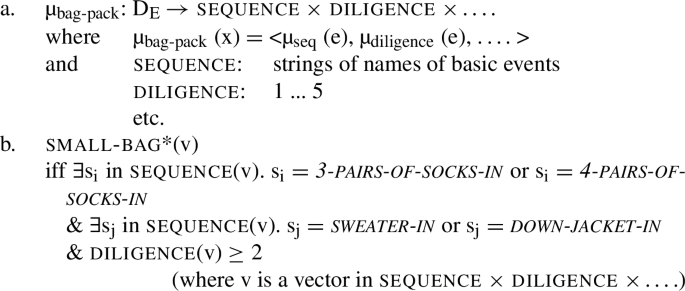
-
(36)

In concluding, it is important to note that the notion of similarity in this framework is qualitative (feature-based, see Tversky 1977) unlike that in Gärdenfors’ (2000) conceptual spaces which is quantitative (distance-based). Even more importantly, unlike Gärdenfors’ conceptual spaces, multi-dimensional attribute spaces in our framework are integrated into referential semantics by means of generalized measure functions. These functions map referents (individuals or events) to points in attribute spaces, just like measure functions in degree semantics map individuals to degrees. Similarity in this system is a relation between referents which is defined by means of indistinguishability of corresponding points in attribute spaces (for details see Umbach and Gust 2014 and Gust and Umbach to appear).
5.2 Manner wie-complements
One building block of the analysis of wie-complements in this paper is the interpretation of their manner readings as interrogative clauses and as free relative clauses (see Sect. 4). There is a long-standing dispute in the literature about how to understand the notion of manner. We will briefly go into this issue before presenting our semantic analysis of manner wie-complements.
5.2.1 Are manners primitive ontological entities?
A comprehensive overview over the idea of manner in semantics is given in Piñón (2008): Do they denote properties of events, or are they primitive ontological entities? Do they exist independently of a specific event? How are they related to an event? Is there a single manner of an event, or are there multiple ones corresponding to different aspects? For the various positions see the references in Piñón (2008), and see Schäfer (2013) and Alexeyenko (2015).
The common way of talking about manner in the current literature is such that manners are primitive entities and there is a manner function from events to manners. Adverbs are then interpreted as predicates on manner entities. An example along the lines of Schäfer (2013) is shown in (37). In (b) an unspecific function manner is used, in (c) the manner function is specified for a particular type of event, m-dance, which is an alternative considered by Schäfer.
-
(37)

The representation in (37c) is surprisingly close to the idea of multi-dimensional attribute spaces presented in the preceding section. If we think of the manner function as a generalized measure function and the manner variable m as ranging over points in attribute spaces, (37c) corresponds to (38):
-
(38)

In our framework, points in attribute spaces differ from referential entities like individuals and events in being mere auxiliaries facilitating classification of individuals and events with respect to certain properties. They are dependent on the individuals or events they are attributes of. Their ontological status is analogous to that of degrees in degree semantics—points in the attribute space are auxiliary units just like degrees.
The interpretation of wie-complements raises the question of what the domain is that the wh-word wie ranges over. Since we do not consider points in attribute spaces to be on par with individuals and events, we prefer thinking of wie as ranging over sets of events mapped by manner measuring functions onto points in attribute spaces. If we allow for some granularity such that closely adjacent points are indistinguishable, such sets of events constitute similarity classes: sets of all events for which the measure functions yields indistinguishable values, see (39).
-
(39)

This view may at first sight appear unnecessarily complex—why talk about similarity classes instead of primitive manner entities?—but it has three significant advantages. First, we get a little closer to the internal make-up of manners. The similarity framework does not tell us which measure functions are relevant for a particular manner, but it allows predictions that can be tested empirically (see Umbach and Stolterfoht in preparation). Second, analyzing the wh-word wie in wie-complements as similarity shows the connections to other uses of wie, e.g., in equatives, see (32) above. Third, and most important in this paper: The similarity analysis of manner reveals what manner and eventive wie-complements have in common and provides an answer to the question we started out from, namely why a manner question word is used to indicate an event in progress.
One argument raised against the similarity approach is about perception. Seeing how Anna dances should not be analyzed such that it entails seeing all similar events. We assume that perceiving a manner in form of a similarity class, as in (39), entails perceiving the ‘seed event’ of this set (variable e in 39). The other elements of the class are indistinguishable from the ‘seed event’ with respect to certain features of comparison, but they are not indistinguishable per se. Indistinguishability does not entail identity (see Umbach and Gust 2021), and thus similar/indistinguishable events will not be simultaneously perceived. What we see when seeing how Anna dances is, first, Anna dancing—this is why wie-complements entail direct perception—and, secondly, that her dancing has attributes with respect to which her dancing is indistinguishable from other dancing events. In contrast to the manner-as-primitives view, according to which what is seen is a manner object, the similarity view retains the link between event and manner, which is an acknowledged problem for the manner-as-primitives analysis (see Alexeyenko 2015) and it avoids the debate on whether primitive manner objects can be perceived as such.
5.2.2 Manner wie-complements interpreted by similarity
We saw in Sect. 2 that manner wie-complements occur, on the one hand, embedded under perception verbs, cognitive verbs and report verbs and, on the other hand, under interrogative and factive verbs, see (15a,b). In Sect. 4, the former were analyzed as free relative clauses and the latter as interrogative clauses, with wie being base-generated in the manner position adjacent to the verb in both cases. Before going into the similarity analysis of manner wie-complements, let us see what the interpretation would look like if we consider manners as primitive entities related to the event by a manner relation. The free relative interpretation is shown in (40), the interrogative one in (41).Footnote 14
-
(40)

-
(41)

The reason why we think that the analysis above is unsatisfactory has been laid out in the previous section. Most importantly, it cannot—as far as we can see—be extended to account for eventive wie. Using primitive manner entities would thus predict that the manner reading and the eventive reading of wie-complements are unrelated, which would be an unsatisfactory result.
We propose the similarity-based analyses in (42) and (43). It is important to note that they are not fundamentally different from standard semantic interpretations in (40)/(41). They are just more detailed and spell out the making of manner objects. In (42) the interpretation of a manner free relative clause is shown. As in the case of equatives (Sect. 5.1), wie denotes a similarity relation: \(\lambda e'\).λe.SIM(\(e', e, \mathcal{F}\)) (recall that the parameter ℱ includes the relevant dimensions of comparison and is given by context). Combining wie with the verb yields (c)/(d), where combination is simply intersective modification. This is analogous to the manner-as-primitive-entity version in (40), where manner also functions as an intersective modifier. The only difference between the similarity version and the manner-as-primitive-entity version is that in the former m is of type <e,t> instead of e and is connected to the event by being a class of similar events (with respect to ℱ) instead of being manner-related to the event. In (e), the free relative clause is type-shifted from <e,t> to <e> by the iota operator taking sets to (maximal) plural individuals.Footnote 15 We assume that the event variable is bound by existential closure only after adding the matrix clause, cf. (f).
-
(42)

In (43) the interpretation of a manner interrogative clause is shown. We make use of a simplified Karttunen-style analysis such that embedded interrogatives denote questions and questions are sets of (true) propositions (Karttunen 1977). We neglect the details of question semantics and instead focus on the role of manner. From the point of view of manners-as-primitive-entities, propositions range over manners in the same way they range over persons in, e.g., (44). If manners are viewed as similarity classes, propositions have to range over similarity classes. Similarity classes of a given event vary with respect to representations ℱ. So propositions range over the set of similarity classes of a given event varying in ℱ—in prose, the set of manners in which an event of the given event type can be performed. Such a domain is defined by M(e) = {m | \(\exists \mathcal{F}\). m = {e′| sim(e′, e, ℱ) }}.Footnote 16
-
(43)
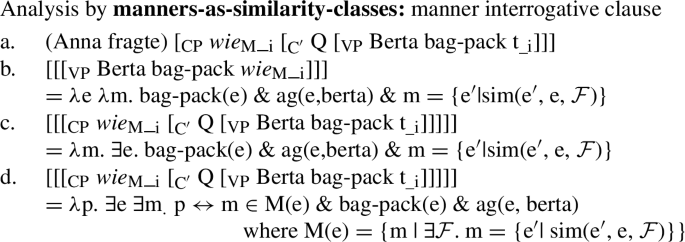
-
(44)

We started this section by explaining the notion of manner by similarity of events. Similarity classes of events are akin to event kinds in sharing “in virtue of” properties (see Sect. 5.1). This suggests that the reification of (the denotations of) free relative clauses might in fact result in kinds rather than (maximal) plural individuals. An analysis along this path would be beyond the scope of this article. However, if you wonder what sort of an individual a similarity class might be, think of it as a kind.
5.3 The meaning of eventive wie-complements
The core issue in this paper is the semantics of eventive wie-complements, and the main motivation for the additional effort of explaining manners by similarity is that in this way the connection between manner and eventive wie complements will be transparent. The most important empirical observation on eventive wie-complements is that they have a process-like character. So our hypothesis is that eventive wie-complements are imperfective in the sense of presenting a process as ongoing. Starting from the commonly accepted idea that events in progress are associated with a set of possible continuations, we will suggest an analysis of such events as similarity classes built from an initial event sequence—the sequence that is observed—plus possible natural continuations. According to this analysis, events in progress constitute a special sort of manner similarity classes, special in three respects. First, these classes represent methods, that is, sequences of subevents of an event of a given type. Second, the sequences are similar to a natural course of events of the relevant type. Third, all sequences share a common initial sequence, or stage, that has already been realized.
We will start with providing evidence that eventive wie-complements do in fact denote events in progress, then discuss the basic characteristics of events in progress and how they were accounted for in Landman (1992) and in Bonomi (1997), and finally suggest a semantics for eventive wie-complements. To be clear from the outset, we do not claim that wie is a progressive operator analogous to progressive morphology in English. In our analysis, wie selects for an event in progress—a stage—in order to build a similarity class of natural continuations.
5.3.1 Eventive wie-complements denote events in progress
The characterization of eventive wie-complements in the literature is mostly negative: They don’t express a manner of performing an event, they cannot be used as embedded questions and, syntactically, the wh-word has not been moved. Moreover, they are not equivalent to dass (‘that’) complements, since they cannot be embedded under glauben (‘believe’) and, unlike dass-complements, they entail direct perception when embedded under perception verbs—Anna sah wieE Berta ihre Tasche packte. (‘Anna saw how Berta packed her bag.’) entails that Anna actually saw Berta packing her bag—mere evidence, such as clothing scattered across the room, would not suffice.
The only positive characterization found in the literature is the commonly agreed on intuition that \(\mathit{wie}_{\mathrm{E}}\)-complements indicate a process perspective—they describe a process or scene. From this observation, Falkenberg (1989) draws the conclusion that eventive wie-complements are imperfective, like English progressive clauses. He shows that they allow for the so-called imperfective paradox—(45a) does not entail that the crossing of the river event was completed while (45b) does. Thus a continuation by Sie kam aber nicht auf der anderen Seite an. (‘But she did not reach the other side.’) would be consistent in the case of (45a), but not in the case of (45b). Falkenberg furthermore points out that eventive wie-complements may contain “dabei sein” constructions (‘be in the process of doing sth.’) as in (46a) and also the Rheinische Verlaufsform (Rhenish progressive) which is a non-standard German progressive form, (46b).
-
(45)

-
(46)

We follow Falkenberg in assuming that \(\mathit{wie}_{\mathrm{E}}\)-complements are imperfective in the sense of viewpoint aspect: the situation is presented from the inside, as an ongoing event. In English, imperfectivity is marked by progressive morphology (for details see Deo 2020). In German, imperfectivity is mostly unmarked since simple tenses are indeterminate between a progressive and non-progressive interpretation. Possible markers are particles like gerade ‘just’ and “dabei sein” constructions, and also the (non-standard) Rheinische Verlaufsform. Eventive wie-complements are in fact compatible with these markers, see (46). Moreover, if it is true that eventive wie-complements select for imperfectivity, they should conform to the well-known constraints on lexical aspect, i.e. they should license activities and accomplishments but not states and achievements.
States are excluded in \(\mathit{wie}_{\mathrm{E}}\)-complements, see (47a) (= 21 in Vater 1975). This is independent of whether they express stage level or individual level predicates (47a,b). Verbs of position like stand, sit, lie, though clearly stative, may in rare contexts occur in English progressives, (48) (= 10a in Deo 2020). In \(\mathit{wie}_{\mathrm{E}}\)-complements, position verbs are hardly acceptable, (49a). The sentences improve, however, by adding an activity conjunct, (49b,c). This effect is reminiscent of the pseudo-coordination form of progressives in Norwegian in which a position verb is combined with an activity.Footnote 17 Without going into details, we will consider this effect as support for the claim that \(\mathit{wie}_{\mathrm{E}}\)-complements reject statives.
-
(47)
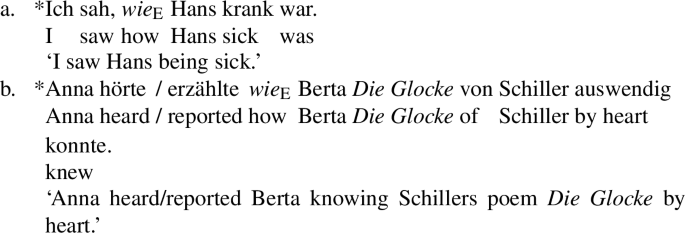
-
(48)

-
(49)
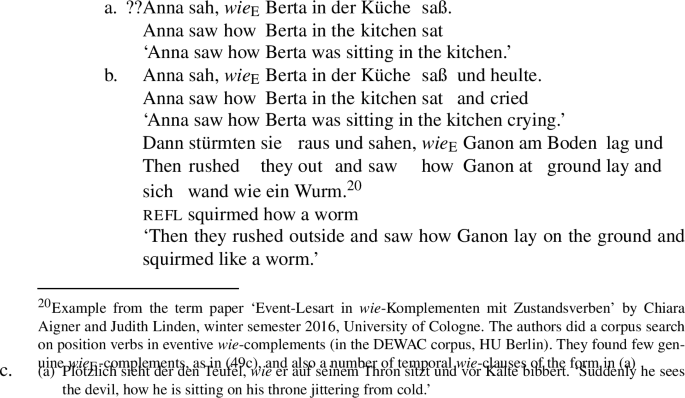
Contrary to expectation, achievements are not excluded in \(\mathit{wie}_{\mathrm{E}}\)-complements. But if they occur they have either an accomplishment-like reading with an additional preparatory phase, or they have a slow-motion reading, see (50a,b).
-
(50)

Accomplishment-like readings as well as slow-motion readings have been observed by Rothstein (2004) for English achievement verbs occurring in the progressive. The former are available for the majority of achievement verbs and add a short preparatory phase to the instantaneous event expressed by the achievement. The latter are always available; they make the instantaneous event appear as being stretched over time. Rothstein furthermore observes that the former pattern with accomplishments in not entailing the completed event, and thereby license the imperfective paradox, while the latter pattern with activities since they do entail the completed event and block the imperfective paradox, see (50c,d) below (Rothstein 2004:(8b), 39 and (48a), 57).
-
(51)

5.3.2 Events in progress construed as stages in method similarity classes
The semantics of imperfective sentences and, in particular, the English progressive has been discussed at length in the literature; see, e.g., Dowty (1979), Landman (1992), Bonomi (1997), Portner (1998) and, recently, Fiorin and Delfitto (2017) and Varasdi (2017); for an overview see Deo (2020).
The basic idea is that imperfectivity indicates viewing an event “from the inside” or as “ongoing.” Accordingly, the reference time is included in the event time. In (51a) the reference time is that of the matrix event; imperfectivity of \(\mathit{wie}_{\mathrm{E}}\)-complements would predict that Anna did not necessarily watch all of Berta’s bag-packing. This is what we find, see (51b).
-
(52)
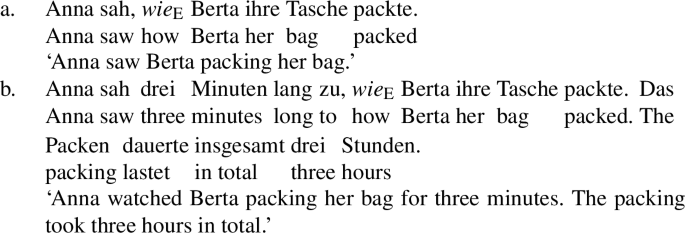
The ‘ongoing’ characteristic entails that the event segment denoted by the imperfective sentence is continued. When Anna sees Berta packing her bag she will not expect Berta to stop as soon as she leaves the room, but instead she will assume that Berta continues when she is no longer watching. This type of expectation is subsumed under the notion of inertia in cognitive science. Furthermore, if the speaker describes Berta’s activity as being of the type of bag-packing, expected continuations are of the same type. Or, from Anna’s point of view, if she classified Berta’s activity as being of the type of bag-packing she will expect its continuation to be of the type of bag-packing, too.Footnote 18 So if Anna is asked: what is Berta doing there? she would answer: Berta ist am Koffer packen. / Berta is packing her bag. even though she doesn’t see more than Berta rummaging around in her belongings.
The discussion in the literature centers around the question of which requirements have to be met by continuations of the event in order for the imperfective sentence to be true. Which interruptions would falsify the truth of Berta is packing her bag? Intuitively, the sentence is true even if the bag-packing stops due to an earthquake. But it is not true if the process stops because Berta realizes that there is nothing available to put in the bag (maybe because she is in the wrong room). The idea of truth-preserving interruptions is the core question of the famous imperfective paradox.Footnote 19 It led to the idea of inertia worlds, which are worlds identical to the actual world up to reference time and from there on everything takes a natural course—nothing unexpected happens. Based on the idea of inertia worlds Dowty (1979) proposed that Mary is building a house is true in a world w at an interval i iff in every inertia world u for w the interval i is a subinterval of a larger interval where Mary build a house is true.
There are a number of problems with possible interruptions and questions of naturalness which led to the event based account in Landman (1992). It makes use of stages of events and continuation branches. Stages are “parts of an event which are big enough and share enough with the event to be called a less developed version of the event” (Landman 1992:23). Continuations match with stages: If an event e is a stage of an event f, then f is a continuation of e. Continuation branches are described by Landman as follows:
“We follow the actual continuation of our event e in our world until it stops. Then we perform a thought experiment: How would e have continued if it hadn’t stopped? But we only do so if the thought experiment is reasonable on the basis of what is internal to e; if the thought experiment brings us to a world where e continues further than is reasonable on the basis of e itself, we don’t perform it.” (Landman 1992:26).
Landman’s implementation makes use of closest (i.e. most similar, Lewis 1973) worlds such that in the case of an interruption in the actual world the continuation of the event in the closest worlds is considered, up to the next interruption, and this is repeated as long as switching to another world is still reasonable. So continuation branches are possible continuations of a given event stage (this is why Varasdi 2017 classifies Landman’s account as a possibility-based theory of the progressive). The stage is realized in the actual world—it is an event token, for example, the stage of Berta’s bag-packing observed by Anna. But we don’t yet know how it will develop from then on because reference time is within event time. Due to cognitive inertia we take only natural continuations of the type of bag-packing into account, and we judge the progressive to be true if we can think of a possible and also natural continuation of the token stage. This is why Mary was crossing the street is true even if she was hit by a truck, and Mary was swimming across the Atlantic is false if after the first 500 meters she is carried to the other side by magic forces.
While in Landman’s account possibility is encoded with the help of possible worlds, the account suggested in Bonomi (1997) is extensional, making use of stereotypical frames and natural courses of events.Footnote 20 Stereotypical frames are functions from events and contexts yielding sets of natural courses of events. Truth conditions of the progressive are defined such that an event e is an event in progress of type V iff there is a stereotypical frame such that each natural course of events licensed by this frame contains an event which is of type V and includes the event in progress. A sentence in the progressive is true in Bonomi’s system if the actual course of events is contained in the natural courses of events selected by the relevant stereotypical frame.
“… Leo is going to Metz is true iff there is an event whose characteristics, with respect to some features of the world and a given stereotypical constraint, force the perception of e as part of a process of Leo’s going to Metz, […] there can still be different chains of events leading to an event of Leo’s getting to Metz. He might take a toll road or a freeway, stop at X rather than Y, and so on. This is why we have to refer to a plurality of courses of events, even though the type of the event which is going on is already definite.” (Bonomi 1997:193-194)
From Bonomi’s analysis to the similarity analysis of eventive wie-complements it is just a few steps. The basic idea of our interpretation of eventive wie-complements is built on three key components. First, sets of courses of events correspond to methods, that is, to sets of sequences of subevents performing an event of a certain type (for example, sequences of subevents adding up to a bag-packing event). Secondly, the stage of the event realized up to reference time—the stage of Berta’s bag-packing observed by Anna—is a token corresponding to an initial sequence of a bag-packing sequence. Thirdly, even though the initial stage has various continuations, namely all the sequences it is an initial part of, the truth of the sentence should be confined to natural sequences only—the stage of Berta’s activity is truly described by wie Berta ihren Koffer packt if there are natural continuations of this stage which are of the type bag-packing.
The role of wie in eventive wie-complements is to create a similarity class reflecting these components. Note that the similarity class is a hybrid: while a run-of-the-mill method is a class of courses of events (and combines intersectively with the event type given by the verbal predicate), the method induced by eventive wie depends on a given token and includes all courses of events this token is a stage of. From the point of view of type theory (Martin-Löf 1984; Cooper in preparation) this is a dependent type.
As argued in Sect. 4, the interpretation of eventive wie-complements is such that the wh-word wie is base-generated in Spec CP (instead of being moved from a verb adjacent position). As in the case of manner wie-complements, wie denotes a similarity relation. Unlike manner wie-complements, the similarity class does not provide an intersective modifier of the event type but instead a constraint attached to an event token (which is available only above VP, Carlson 2003), namely that there have to be natural continuations of the relevant type.
In (52) the interpretation of eventive wie-complements is shown. The VP is interpreted such that there is some rummaging around of Berta’s that is classified by the speaker (as well as Anna) as being a stage of bag-packing, and due to cognitive inertia the speaker (as well as Anna) assume that Berta’s rummaging around will develop into a natural bag-packing event.
Note that imperfectivity arises already at this point, by the assumption that the activity given at reference time is part of a fully developed event. This is expressed by the initial-sequence-of relation—e is a stage of a bag-pack event f, e ≼ f.Footnote 21 In (standard) German there is no morphological difference between simple tense und progressive, but in the Rhineland dialect the VP in (52a) could be expressed in a progressive form: Berta ist am Tasche packen, see (46b).
As in the case of manner wie-complements, similarity imposes a constraint, but due to the high position of wie it does not affect the event type of bag-packing but instead the event token, that is, the stage of Berta’s rummaging around. This is implemented in (52d) by requiring that the event token e must be an initial part of all natural bag-packing events in the similarity class. In (52e) the free relative clause is type-shifted from <e,t> to <e> by iota yielding an event which is the theme of the seeing event in the matrix clause in (52f).Footnote 22
-
(53)
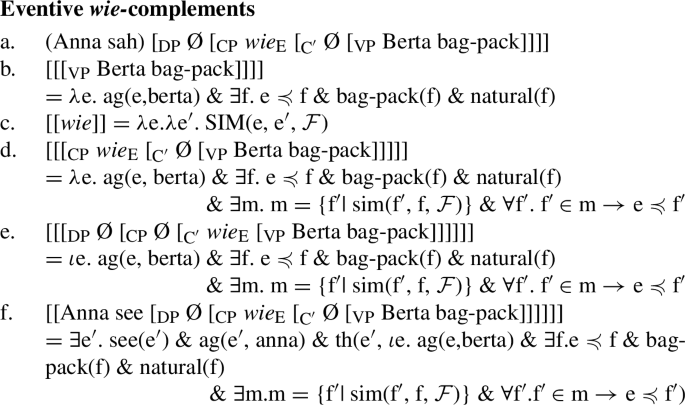
Comparing the interpretation of eventive wie-complements in (52) to that of manner wie-complements in (42), the difference in meaning is inherently connected to the difference in syntax. We follow Carlson (2003) in assuming that the lexical projection of a major phrase contains only type information while token information is made available only in higher functional projections. In the manner reading of wie-complements the wh-word is base-generated below VP and thus has access to the event type; the similarity class functions as an intersective modifier, and this is what we expect from a manner modifier. In contrast, in the eventive reading the wh-word is base-generated above VP and has access only to the event token. The similarity class provides a constraint on the event token by postulating natural continuations. In this case, the similarity class functions as a non-restrictive modifier. We do not call the token modifier a manner modifier in order to avoid confusion. However, if we see manners as similarity classes of events, the token modifier is a manner modifier, too.
In this analysis, the modal impact of imperfectivity is encoded in the similarity analysis by the type-token distinction. While the stage referred to by a progressive sentence is a token, the set of continuations is a type constituted by possible continuations—only one of them will be realized (if at all). From this point of view our analysis draws on possibilities although not on possible worlds.
Finally, one might think that German wie in eventive complements is a progressive operator analogous to progressive morphology in English. However, in our analysis eventive wie presupposes a stage in order to build the dependent similarity class, and it is the notion of the stage indicating that the event is ‘ongoing,’ that is, reference time is within event time. In Deo (2020) two roles of grammatical devices (obligatory vs. optional) are distinguished in signaling the presence of imperfectivity: Either they induce imperfectivity or they merely presuppose imperfectivity. In our analysis, wie in eventive complements takes the latter role. Still, since in German simple tenses are ambiguous between a perfective and an imperfective reading, eventive wie non-vacuously indicates an imperfective interpretation.
6 Conclusion
The central issue addressed in this paper is the semantics of eventive wie-complements in contrast to manner wie-complements. This includes a number of questions, the most puzzling of which is: Why is a manner word used to indicate an event in progress?
The answer is given in two steps. First, we argue that the wh-word wie should not be considered as ranging over primitive manner objects but instead be interpreted as expressing similarity. Manners are made by similarity classes—classes of events sharing a set of features.
This view makes the commonality of the two types of wie-complements visible: They both involve similarity classes. But while in the case of manner complements the similarity class restricts the event type, in the case of eventive complements it adds information about an event token, namely that it is a stage in a set of similar natural continuations.
The idea of natural continuations reflects the idea of an event being in progress. In the similarity account, natural continuations are provided as a similarity class of sequences of subevents sharing the same initial sequence. From this perspective the question we started out from can be answered as follows: The wh-word wie expresses similarity, and both the manner reading and the eventive reading of wie-complements involve similarity classes. In the manner reading similarity classes reflect arbitrary properties of events and function as restrictive modifiers of event types. In the eventive reading similarity classes non-restrictively modify event tokens by wrapping them into a class of similar continuations. So the form of the similarity class in eventive readings is a special case of a general manner similarity class (and it might be called a manner, too, though we do not in order to avoid confusion).
The similarity analysis explains why wie-complements have a manner as well as an eventive reading without postulating two homophonous versions of the wh-word. It accounts for the different syntactic characteristics the wh-word—being moved from a base position adjacent to the verb as opposed to being base-generated above VP—and it accounts for the observation that eventive wie-complements express events in progress. Finally, it accounts for the finding that all matrix verbs that license free relative manner readings also license eventive readings: the latter are just a special case of the former. This may explain why it is sometimes hard to distinguish the two readings.
The similarity analysis opens the door for future work on a uniform interpretation of the German wh-word wie across syntactic constructions, including equative comparison, temporal wie-clauses, wie appositions and also overt wie-questions. It also offers the opportunity to take a fresh look at the topic of manner modification. The most exciting puzzle for future work, however, is this: Non-manner uses of manner wh-words are found in a broad variety of European and non-European languages, but their meaning seems to vary. Is there nevertheless a systematic relation between manner wh-words and non-manner uses thereof across languages?
Notes
Another possibility of translation would be a progressive how clause: Anna saw how Berta was packing her bag. But since non-manner how clauses in English differ in various respects from those in German, we will stick to the gerund participle whenever possible.
Some speakers insist that a manner interpretation of (9) is possible, in the sense of Anna seeing the manner of Berta’s quickly packing her bag. In fact (10) is slightly improved by choosing a method continuation instead of pure manner (… nämlich indem sie alle Sachen einfach reinwarf. ‘namely by simply throwing all things in’). It is further improved by choosing an achievement verb (Anna sah, WIE Berta ihre Tasche schnell gepackt kriegte. ‘Anna saw HOW Berta got her bag quickly packed.’) Still, speakers in general dislike a manner reading if there is a gradable adverb next to the verb.
There is one type of verbs embedding eventive readings but not manner readings, namely träumen / sich vorstellen ‘dream’ / ‘imagine’:
-
(a)
Er wachte vor Lachen auf, weil er geträumt hatte, wie er einen Witz (laut) erzählt.
‘He woke up laughing because he dreamt that he told a joke (aloud).’
(example from the ZAS database on sentence embedding predicates (cf. www.leibniz-zas.de).
-
(a)
They are taken from the DEWAC corpus provided by the Corpuslinguistics group at the Humboldt University Berlin, and from newspapers.
Here is a headline with a manner reading: Wie man Dornröschen wach küsst, ‘How to kiss Sleeping Beauty awake,’ title of a Czechoslovak fairy tale film.
Again, there are different manners in which one can kill somebody cruelly. But adding one of these is dispreferred. Robin Cooper pointed out that in English the position of the adverb is crucial. The sentence in (a) is clearly better than the one in (b).
-
(a)
He figured out how Alex cruelly killed his body guard, namely with a letter opener.
-
(b)
(?) He figured out how Alex killed his body guard cruelly, namely with a letter opener.
In German, the contrast between (a) and (b) cannot be achieved through different adverb positions. German doesn’t allow for adverbs in postposition and, as a rule, the position directly preceding the verb corresponds (semantically) to English postposition.
-
(a)
While German eventive wie-complements do not entail completion (see Sect. 5.3.1), English non-manner how-complements do if not combined with a progressive (Stephanie Solt / Robin Cooper, p.c.):
-
(a)
I saw you cross the street.
-
(b)
I saw you crossing the street [but after I looked away, I heard the car hit you].
-
(c)
I saw how you crossed the street to avoid meeting Fred, who was walking towards you.
-
(d)
I saw how you crossed the street, #but after I looked away, I heard the car hit you.
-
(e)
I saw how you were crossing the street, but after I looked away, I heard the car hit you.
In (a), (c) and (d) the crossing event has to be completed.
-
(a)
Schäfer (2013) provides a more fine-grained classification of manner adverbs distinguishing between (his) pure manner, agent-oriented manner, method-oriented manner and degree. For the purpose of our paper the simpler classification is sufficient.
In Sect. 2 cases were mentioned in which a manner interpretation cannot be excluded with certainty even though the verb adjacent manner position is occupied, see fn. 2 and 7. However, cases like this are rare and dispreferred by native speakers.
Similarly, one reviewer wonders whether wie can be manner if the adverb is combined with a demonstrative. This is in fact possible if wie refers to, e.g., an instrument, that is, manner-instrument is added to pure manner:
-
(i)

Note that wie in this example is equivalent to warum ‘why’, which is presumably due to the matrix verb verstehen ‘understand’ and results in a high base position—another future topic.
-
(i)
We use the term similarity class although they are just sets because the term is established in the literature on similarity and conveys the idea of classification.
The combination of the wie-clause with the parameter part of the equative looks like this: We assume that the pronominal element so denotes similarity, as does wie, but in addition has an anaphoric or deictic capacity represented by a free variable target. Thus the parameter part of the equative is interpreted as in (32c). The free variables target and \(m'\) are introduced by so expressing that Anna’s dancing is in the set of events \(m'\) that are similar to target. The wie-clause is combined with the matrix clause by identifying m and \(m'\), which is achieved by (simplified) unification, ⊕: the free variable target is instantiated by the token event of Berta’s dancing \(e''\), and the features of comparison in ℱ and ℱ’ must be identical, (32d). This derivation accounts for the correlative status of so in equatives.
-
(i)

-
(i)
It is an interesting open question how tight this reflection has to be in terms of temporal development (Louise McNally, p.c.).
For the sake of transparency, we summarize die Tasche packen in these and the following representations in a single predicate bag-pack.
One reviewer suggested rephrasing (43d) such that e and ℱ are existentially quantified over while dismissing the explicit mention of the domain M(e). This is simpler and in fact equivalent. But since we want to make the domain explicit, we leave (43d) as it is and add the rephrase here:
-
(i)

-
(i)
See Tonne (2006); her example (1a) is ‘Bama satt og leste.’ (lit: the children sat and read), which means that the children were reading but not necessarily sitting. The position verb is prototypical for the activity but not entailed (sit in the kitchen and cry; stand and talk on the telephone etc.); p.c. Atle Groenn.
Relatedly, \(\mathit{wie}_{\mathrm{E}}\)-complements are not epistemically neutral in the sense of Barwise, that is, (51a) entails that Anna thinks Berta is packing her bag.
The imperfective paradox points to the observation that for activities, as in (1), but not for accomplishments, as in (2), the entailment from (a) to (b) holds, see the concise presentation in Varasdi (2017).
-
(i)

-
(i)

If (2a) is interrupted by some unforeseen accident it is still true while (2b) is false. (2a) is still true because normally Mary would reach the other side of the street. This is different in Mary was crossing the Atlantic (by swimming). This sentence is false even if Mary, after holding on for 500 m, is carried to the other side by magic forces, since that would not count as a natural continuation.
-
(i)
“The idea is that our perception of an event involves a bunch of possible developments of that event. My going to the blackboard and taking a piece of chalk can be considered as part of a number of alternative events, such as putting the room in order, writing some instructions, proving a theorem, and so on. Since the same event e can be ‘embedded’ into several possible continuations, the context is a determining factor in selecting the relevant ones. If e is considered in connection with a given set of concomitant facts, then its possible extensions are events of a certain type. But if another set of concomitant facts is selected as the relevant background, then the type of the global event which is considered in progress will be different.” (Bonomi 1997:174).
Two remarks: We assume that agents stay constant during the development of an event. Second, the definition of initial-sequence in Sect. 5.1 does not exclude degenerate cases covering the overall sequence. We leave this issue open since the data are not fully clear.
Note that the variable m in (52d, e, f) is strictly speaking superfluous and is “syntactic sugar” meant to visualize the idea.
References
Alexeyenko, Sascha. 2015. The syntax and semantics of manner modification: Adjectives and adverbs. PhD diss., University of Osnabrück.
Anderson, Curt, and Marcin Morzycki. 2015. Degrees as kinds. Natural Language and Linguistic Theory 33(3): 791–821.
Barwise, Jon. 1989. Scenes and other situations. In The situation in logic, ed. Jon Barwise, Vol. 17 of CSLI lecture notes.
Bayer, Josef. 1986. The role of event expression in grammar. Studies in Languages 10(1): 1–52.
Behrens, Bergljot, and Cathrine Fabricius-Hansen. 2002. Connectives in contrast: A discourse semantic study of elaboration based on corpus research. In Information structure in a cross-linguistic perspective, eds. Hilde Hasselgård, Stig Johansson, Bergljot Behrens, and Cathrine Fabricius-Hansen, 45–61. Amsterdam: Rodopi.
Bonomi, Andrea. 1997. The progressive and the structure of events. Journal of Semantics 14: 173–205.
Caponigro, Ivano. 2004. The semantic contribution of WH-words and type shifts: Evidence from free relatives crosslinguistically. In Semantics and Linguistic Theory (SALT), ed. Robert B. Young. Vol. 14. Cornell: CLC.
Carlson, Greg. 2003. Interpretive asymmetries in Major phrases. In Asymmetry in linguistic theory, ed. Anna Maria DiSciullo, 299–311. Amsterdam: Benjamins.
Clement, Danielle. 1971. Satzeinbettungen nach Verben der Sinneswahrnehmung. In Probleme und Fortschritte der Transformationsgrammatik, ed. Dieter Wunderlich. 245–265. München: Hueber.
Cooper, Robin, in preparation. Type theory and language: From perception to linguistic communication.
Demirdache, Hamida, and Myriam Uribe-Etxebarria. 2004. The syntax of time adverbs. In The syntax of time, eds. Jacqueline Lecarme and Jacqueline Gueron. Cambridge: MIT Press.
Deo, Ashwini. 2020. Imperfectivity. In Companion to semantics, eds. Lisa Matthewson, Cecile Meier, Hotze Rullmann, and Thomas E. Zimmermann. New York: Wiley Blackwell.
Dowty, David. 1979. Word meaning and Montague grammar. Dordrecht: Reidel.
Duden. 2006. Die Grammatik. Mannheim: Dudenverlag.
Falkenberg, Gabriel. 1989. Einige Bemerkungen zu perzeptiven Verben. In Wissen, wahrnehmen, glauben, ed. Gabriel Falkenberg, 27–45. Tübingen: Niemeyer.
Fernando, Tim. 2015. The semantics of tense and aspect: A finite-state perspective. In The handbook of contemporary semantic theory, eds. Shalom Lappin and Chris Fox, 203–236. Hoboken: Wiley.
Fiorin, Gaetano, and Denis Delfitto. 2017. A perspective-based account of the imperfective paradox. In Formal models in the study of language, eds. Joanna Blochowiak, Cristina Grisot, Stephanie Durrleman, and Christopher Laenzlinger. Berlin: Springer.
Frey, Werner. 2003. Syntactic conditions on adjunct classes. In Modifying adjuncts, eds. Ewald Lang, Claudia Maienborn, and Cathrine Fabricius-Hansen, 163–209. Berlin: Mouton de Gruyter.
Gärdenfors, Peter. 2000. Conceptual spaces. Cambridge: MIT Press.
Greenberg, Yael. 2003. Manifestations of genericity. New York: Routledge.
Gust, Helmar, and Carla Umbach, to appear. A qualitative similarity framework for the interpretation of natural Language similarity expressions. In Concepts in action—representation, learning and application. Language, cognition, and mind, eds. Lucas Bechberger, Kai-Uwe Kühnberger, and Mingya Liu. Berlin: Springer.
Hinterwimmer, Stefan. 2013. Free relatives as kind-denoting terms. In Genericity, eds. Claire Beyssade, Fabio Del Prete, and Alda Mari, 140–156. Oxford: Oxford University Press.
Huddleston, Rodney, and Geoffrey Pullum. 2002. The Cambridge grammar of the English language. Cambridge: Cambridge University Press.
Jaworski, William. 2009. The logic of how-questions. Synthese 166: 133–155.
Jędrzejowski, Lukasz, and Carla Umbach, in preparation. Non-interrogative subordinated wh-clauses. Oxford: Oxford University Press.
Karttunen, Lauri. 1977. Syntax and semantics of questions. Linguistics and Philosophy 1: 3–44.
Kastner, I. 2015. Factivity mirrors interpretation: The selectional requirements of presuppositional verbs. Lingua 164: 156–188.
Kearns, Kate. 2003. Durative achievements and individual-level predicates on events. Linguistics and Philosophy 26: 595–635.
Kennedy, C. 1999. Projecting the adjective. New York: Garland Press.
König, Ekkehard, and Carla Umbach. 2018. Demonstratives of manner, of quality and of degree: A neglected subclass. In Atypical demonstratives: Syntax, semantics and typology, eds. Marco Coniglio, Andrew Murphy, Eva Schlachter, and Tonjes Veenstra. Berlin: de Gruyter Mouton.
Landman, Fred. 1992. The progressive. Natural Language Semantics 1: 1–32.
Legate, Julie Anne 2010. On how how is used instead of that. Natural Language and Linguistic Theory 28: 121–134.
Lewis, David. 1973. Counterfactuals. Oxford: Blackwell Publishers/Cambridge: Harvard University Press.
Liefke, Kristina, to appear. Non-manner how-complements in English and German. Proceedings of Sinn & Bedeutung 25, 2020. London.
Maienborn, Claudia. 2003. Event-internal adverbials: Semantic underspecification and conceptual interpretation. In Modifying adjuncts, eds. Ewald Lang, Claudia Maienborn, and Cathrine Fabricius-Hansen, 475–509. Berlin: de Gruyter.
Martin-Löf, Per. 1984. Intuitionistic type theory. Naples: Bibliopolis.
Mieskes, Sarah, Natasha Pracejus, and Hibatulnaseer Nasir. 2007. ‘Wie’-Komplemente. Term paper seminar “Reference to facts & events”. University of Osnabrück, summer semester 2007.
Nye, Rachel. 2013. How complement clauses distribute: Complementiser-‘how’ and the case against clause-type. PhD diss., Universiteit Gent.
Piñón, Christopher. 2008. From properties to manners: A historical line of thought about manner adverbs. In Studies van de Belgische Kring voor Linguïstiek—Travaux du Cercle Belge de Linguistique, Vol. 3 of Papers of the Linguistic Society of Belgium.
Portner, Paul. 1998. The progressive in modal semantics. Language 74: 760–787.
Rothstein, Susan. 2004. Structuring events: A study in the semantics of lexical aspect. London: Blackwell.
Sæbø, Kjell Johan. 2008. The structure of criterion predicates. In Event structures in linguistic form and interpretation, eds. Johannes Dölling, Tatjana Heyde-Zybatow, and Martin Schäfer, 127–147. Berlin: Mouton de Gruyter.
Sæbø, Kjell Johan. 2016. “How” questions and the manner–method distinction. Synthese 193(10): 3169–3194.
Schäfer, Martin. 2013. Positions and interpretations. German adverbial adjectives at the syntax-semantics interface. Berlin: De Gruyter Mouton.
Tonne, Igebjorg. 2006. Elucidating progressives in Norwegian. In A Festschrift for Kjell Johan Sæbø, eds. Torgrim Solstad, Atle Gronn, and Dag Haug. Oslo: University of Oslo.
Tversky, Amos. 1977. Features of similarity. Psychological Review 84: 327–352.
Umbach, Carla, and Helmar Gust. 2014. Similarity demonstratives. Lingua 149: 74–93.
Umbach, Carla, and Helmar Gust. 2021. Grading similarity. In Concepts, frames and cascades in semantics, cognition and ontology, eds. Sebastian Löbner, Thomas Gamerschlag, Tobias Kalenscher, Markus Schrenk, and Henk Zeevat. Berlin: Springer.
Umbach, Carla, and Britta Stolterfoht, in preparation. Ad-hoc kind formation by similarity.
Vater, Heinz. 1975. Wie-Sätze. In Grammatik. Akten des 10. Linguistischen Kolloquiums 2, eds. Kurt Braunmüller and Wilfried Kürschner. Tübingen, 209–222.
Varasdi, Karoly. 2017. Worlds, events, and inertia. Journal of Logic, Language and Information 26(3): 303–332. https://doi.org/10.1007/S10849-017-9253-3.
Zifonun, Gisela, Ludger Hoffmann, and Bruno Strecker. 1997. Grammatik der deutschen Sprache. Berlin: de Gruyter.
Zimmermann, Ilse. 1991. Die subordinierende Konjunktion wie. In Fragesätze und Fragen, Linguistische Arbeiten 257, eds. Marga Reis and Inger Rosengren, 113-122. Tübingen: Niemeyer.
Acknowledgements
The research in this paper started in the Osnabrück OntoRef group: Peter Bosch, Louise McNally, Graham Katz, Philip Miller, Stefan Evert, Judith Degen, Sarah Mieskes, Natasha Pracejus, Hibatulnaseer Nasir. We are moreover very grateful to Louise McNally, Fabienne Martin, Hana Filip, Ilse Zimmermann, Sebastian Bücking, Robin Cooper, Atle Groenn, Lukasz Jedrzejowski, Frank Sode, Werner Frey and Tom McFadden for repeated discussions during the development of this paper and very helpful comments. We would also like to thank the audiences of the event semantics meetings in Düsseldorf 2016 and Heidelberg 2018, the Sklarska workshop 2017, the Tbilisi conference in 2017 and the Riga Symposium of Cognition, Logic and Communication in 2018 for valuable feedback. Finally we would like to express our gratitude to the anonymous reviewers for their detailed and helpful comments. The first author acknowledges funding by the Deutsche Forschungsgemeinschaft, DFG UM 100/1-3.
Funding
Open Access funding enabled and organized by Projekt DEAL.
Author information
Authors and Affiliations
Corresponding author
Additional information
Publisher’s Note
Springer Nature remains neutral with regard to jurisdictional claims in published maps and institutional affiliations.
Rights and permissions
Open Access This article is licensed under a Creative Commons Attribution 4.0 International License, which permits use, sharing, adaptation, distribution and reproduction in any medium or format, as long as you give appropriate credit to the original author(s) and the source, provide a link to the Creative Commons licence, and indicate if changes were made. The images or other third party material in this article are included in the article’s Creative Commons licence, unless indicated otherwise in a credit line to the material. If material is not included in the article’s Creative Commons licence and your intended use is not permitted by statutory regulation or exceeds the permitted use, you will need to obtain permission directly from the copyright holder. To view a copy of this licence, visit http://creativecommons.org/licenses/by/4.0/.
About this article
Cite this article
Umbach, C., Hinterwimmer, S. & Gust, H. German wie-complements. Nat Lang Linguist Theory 40, 307–343 (2022). https://doi.org/10.1007/s11049-021-09508-z
Received:
Accepted:
Published:
Issue Date:
DOI: https://doi.org/10.1007/s11049-021-09508-z






























































